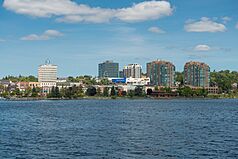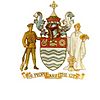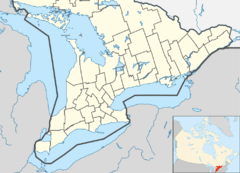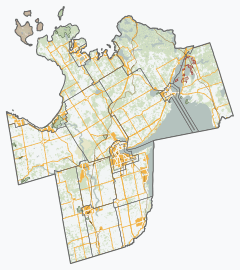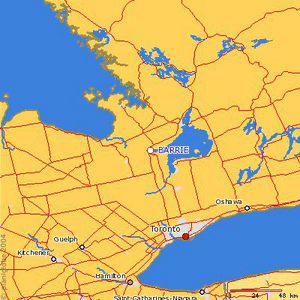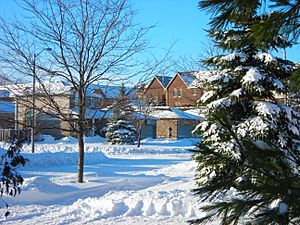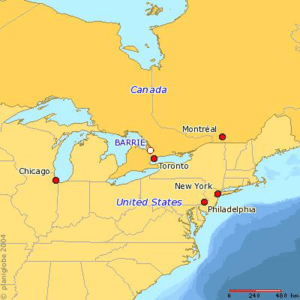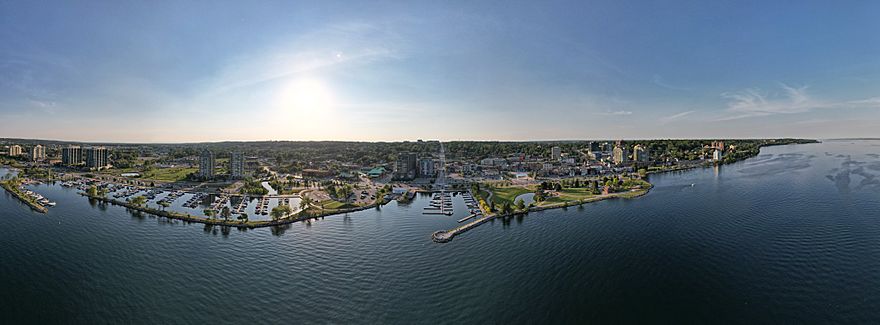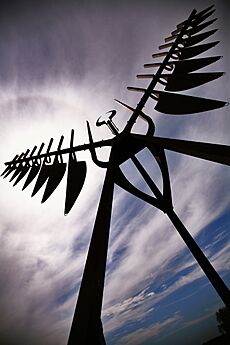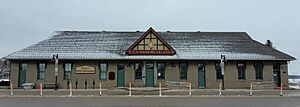Barrie facts for kids
Quick facts for kids
Barrie
|
|||||
|---|---|---|---|---|---|
| City of Barrie | |||||
|
From top, left to right: Downtown Barrie, MacLaren Art Centre, the CKVR-TV Tower, the Spirit Catcher, Sadlon Arena
|
|||||
|
|||||
| Motto(s):
The People are the City
|
|||||
| Country | Canada | ||||
| Province | Ontario | ||||
| County | Simcoe (independent) | ||||
| First settled | End of War of 1812 | ||||
| Established | 1854 (village) | ||||
| Established | 1870 (town) | ||||
| Established | 1959 (city) | ||||
| Named for | Sir Robert Barrie | ||||
| Wards |
10 wards
Ward 1 – Councillor C. Riepma
Ward 2 – Councillor K. Aylwin Ward 3 – Councillor A. Kungl Ward 4 – Councillor B. Ward Ward 5 – Councillor R. Thomson Ward 6 – Councillor N. Harris Ward 7 – Councillor G. Harvey Ward 8 – Councillor J. Harris Ward 9 – Councillor S. Morales Ward 10 – Councillor M. McCann |
||||
| Area | |||||
| • City (single-tier) | 99.01 km2 (38.23 sq mi) | ||||
| • Urban | 171.53 km2 (66.23 sq mi) | ||||
| • Metro | 898.02 km2 (346.73 sq mi) | ||||
| Elevation | 252 m (827 ft) | ||||
| Population
(2021)
|
|||||
| • City (single-tier) | 147,829 | ||||
| • Density | 1,493.1/km2 (3,867/sq mi) | ||||
| • Urban | 172,657 | ||||
| • Urban density | 918.27/km2 (2,378.3/sq mi) | ||||
| • Metro | 212,667 | ||||
| • Metro density | 219.4/km2 (568/sq mi) | ||||
| Time zone | UTC−05:00 (EST) | ||||
| • Summer (DST) | UTC−04:00 (EDT) | ||||
| Forward Sortation Area |
L4M to L4N, L9J, L9X
|
||||
| Area codes | 705, 249, and 683 | ||||
| Highways | Highway 90 |
||||
| GNBC Code | FAFFD | ||||
| GDP (Barrie CMA) | CA$8.6 billion (2020) | ||||
| GDP per capita (Barrie CMA) | CA,735 (2016) | ||||
Barrie is a city in Central Ontario, Canada. It is about 90 kilometers (56 miles) north of Toronto. The city is part of Simcoe County and sits along the shores of Kempenfelt Bay. Even though it is in the county, Barrie manages its own local government. It is also part of a larger urban area in southern Ontario called the Greater Golden Horseshoe.
In 2021, Barrie had a population of 147,829 people. The larger area around it, called the census metropolitan area, had 212,667 residents. The area was first settled during the War of 1812. It was used as a supply base for British soldiers. The city was named after Sir Robert Barrie. In recent years, Barrie has grown a lot. This is partly because of its growing technology industry. It is connected to the Greater Golden Horseshoe by Ontario Highway 400 and GO Transit. Barrie's economy includes education, healthcare, technology, and manufacturing.
Contents
History of Barrie
When Barrie first started, it was a small group of houses and storage buildings. These were located at the end of the Nine Mile Portage. This portage was an old travel route used by Indigenous peoples for hundreds of years. It connected Kempenfelt Bay to Fort Willow. The portage linked Lake Simcoe to the Nottawasaga River, which flows into Georgian Bay off Lake Huron.
Barrie was very important during the War of 1812. It became a supply base for British forces. The Nine Mile Portage was a key part of their supply line. It helped move people, supplies, and equipment to and from Fort Willow and Georgian Bay. Today, you can find signs marking the Nine Mile Portage along roads in Barrie and Springwater Township. You can even follow the path from Memorial Square to Fort Willow.
The city was named in 1833 after Sir Robert Barrie. He was in charge of the naval forces in Canada. He often led his forces through the city and along the Nine Mile Portage.
Barrie was also a final stop for one part of the Underground Railroad. In the mid-1800s, this secret network helped many American slaves find freedom in Barrie. This also helped create the nearby community of Shanty Bay.
By 1869, Barrie was the main town of Simcoe County. It had about 3,000 people. It was a stop on the Northern Railway. It was nicely located on Kempenfelt Bay. Steamers traveled to the Muskoka Territory and Orillia.
During World War II, the Royal Canadian Navy named a ship called HMCS Barrie.
On September 7, 1977, a small plane crashed into the 300-meter (1,000-foot) CKVR-TV tower. Five people on the plane died. The tower and its antenna were destroyed. The station's smaller backup tower was also destroyed. CKVR was back on air with a temporary tower on September 19. A new 300-meter tower was built in 1978.
On May 31, 1985, a very strong F4 tornado hit Barrie. It was one of the most powerful and deadly tornadoes in Canadian history.
In June 1987, a large sculpture called Spirit Catcher by Ron Baird was moved to Barrie. It had been shown at Expo 86 in Vancouver. The sculpture was placed permanently by Kempenfelt Bay.
Barrie's Park Place hosted Live 8 Canada on July 2, 2005. This big concert helped stop plans to turn the area into a shopping district. However, the concert stage and many trees were later removed for new construction.
On December 6, 2007, an explosion happened at the Royal Thai restaurant. It was in the historic Wellington Hotel in downtown Barrie. The fire spread quickly to nearby buildings. Firefighters worked through the night to put out the blaze. The Wellington Hotel, which was over 100 years old, collapsed. Officials estimated the damage to be millions of dollars. In February 2008, two people were charged with starting the fire on purpose.
Geography and Climate
Barrie is in the middle part of Southern Ontario. It is about 90 kilometers (56 miles) north of Toronto. You can reach it using Highways 26, 400, and 11.
Barrie's old downtown area is in a curved valley. It surrounds the western edge of Kempenfelt Bay, which is part of Lake Simcoe. The land is mostly flat near the city center. But as you go towards the north and south, the land can become quite steep.
The city does not have any big rivers. However, it has many creeks and streams. Most of these flow into Kempenfelt Bay.
Communities in Barrie
Barrie is made up of several different communities:
- Letitia Heights
- Cundles
- Ardagh Bluffs
- Eastview
- Holly
- Downtown
- Painswick
- Allandale
- Kingswood
City Growth
The Province of Ontario has named Barrie an Urban Growth Centre. This means it is expected to grow a lot. Its population has increased because many people who work in Toronto choose to live in Barrie. This has led to many new neighborhoods being built in the southern part of the city.
On January 1, 2010, Barrie added 2,293 acres (9.28 square kilometers) of land from the nearby town of Innisfil. This expansion was planned to help Barrie handle its growing population. It also helped avoid building too much into the countryside on the city's other sides.
Weather in Barrie
Barrie has a humid continental climate. This means it has warm, humid summers and cold, snowy winters.
In late spring and summer, Barrie often has strong thunderstorms. This is because of air currents from Georgian Bay, Lake Ontario, and Lake Erie meeting here.
In winter, being close to the Great Lakes makes temperatures a bit milder. But it also brings a lot of snow. Barrie is on the southern edge of Ontario's snowbelt. This is where lake-effect snow falls throughout the winter, mostly from Georgian Bay. About 238 centimeters (95 inches) of snow falls each year. More than half of this is due to lake effect. Snowfall can be much heavier just north of the city compared to the south end.
The hottest temperature ever recorded in Barrie was 38.9°C (102°F) on July 5, 1911. The coldest was -38.9°C (-38°F) on January 8, 1866.
| Climate data for Barrie, 1981−2010 normals, extremes 1866−present | |||||||||||||
|---|---|---|---|---|---|---|---|---|---|---|---|---|---|
| Month | Jan | Feb | Mar | Apr | May | Jun | Jul | Aug | Sep | Oct | Nov | Dec | Year |
| Record high °C (°F) | 15.0 (59.0) |
14.0 (57.2) |
26.5 (79.7) |
30.5 (86.9) |
35.0 (95.0) |
35.6 (96.1) |
38.9 (102.0) |
37.8 (100.0) |
35.6 (96.1) |
30.0 (86.0) |
25.6 (78.1) |
19.5 (67.1) |
38.9 (102.0) |
| Mean daily maximum °C (°F) | −2.9 (26.8) |
−1.5 (29.3) |
3.2 (37.8) |
11.0 (51.8) |
18.1 (64.6) |
23.6 (74.5) |
26.3 (79.3) |
25.1 (77.2) |
20.7 (69.3) |
13.5 (56.3) |
6.5 (43.7) |
0.4 (32.7) |
12.0 (53.6) |
| Daily mean °C (°F) | −7.7 (18.1) |
−6.6 (20.1) |
−2.1 (28.2) |
5.6 (42.1) |
12.3 (54.1) |
17.9 (64.2) |
20.8 (69.4) |
19.7 (67.5) |
15.3 (59.5) |
8.7 (47.7) |
2.7 (36.9) |
−3.5 (25.7) |
6.9 (44.4) |
| Mean daily minimum °C (°F) | −12.4 (9.7) |
−11.7 (10.9) |
−7.4 (18.7) |
0.2 (32.4) |
6.5 (43.7) |
12.3 (54.1) |
15.3 (59.5) |
14.3 (57.7) |
10.0 (50.0) |
3.9 (39.0) |
−1 (30) |
−7.3 (18.9) |
1.9 (35.4) |
| Record low °C (°F) | −38.9 (−38.0) |
−37.2 (−35.0) |
−30.5 (−22.9) |
−15 (5) |
−5.6 (21.9) |
−2.2 (28.0) |
4.4 (39.9) |
0.0 (32.0) |
−3.9 (25.0) |
−8.3 (17.1) |
−21.1 (−6.0) |
−36.7 (−34.1) |
−38.9 (−38.0) |
| Average precipitation mm (inches) | 82.5 (3.25) |
61.8 (2.43) |
58.1 (2.29) |
62.2 (2.45) |
82.4 (3.24) |
84.8 (3.34) |
77.2 (3.04) |
89.9 (3.54) |
94.0 (3.70) |
77.5 (3.05) |
88.9 (3.50) |
73.6 (2.90) |
932.9 (36.73) |
| Average rainfall mm (inches) | 16.6 (0.65) |
16.0 (0.63) |
29.2 (1.15) |
56.6 (2.23) |
82.3 (3.24) |
84.8 (3.34) |
77.2 (3.04) |
89.9 (3.54) |
94.0 (3.70) |
75.2 (2.96) |
66.0 (2.60) |
22.2 (0.87) |
709.9 (27.95) |
| Average snowfall cm (inches) | 65.9 (25.9) |
45.9 (18.1) |
29.0 (11.4) |
5.7 (2.2) |
0.1 (0.0) |
0.0 (0.0) |
0.0 (0.0) |
0.0 (0.0) |
0.0 (0.0) |
2.3 (0.9) |
22.8 (9.0) |
51.4 (20.2) |
223.0 (87.8) |
| Average precipitation days (≥ 0.2 mm) | 14.9 | 12.3 | 11.6 | 12.2 | 12.9 | 11.4 | 11.1 | 11.8 | 13.3 | 15.6 | 15.4 | 13.8 | 156.1 |
| Average rainy days (≥ 0.2 mm) | 2.8 | 3.0 | 5.4 | 11.3 | 12.9 | 11.4 | 11.1 | 11.8 | 13.3 | 15.5 | 11.3 | 4.6 | 114.4 |
| Average snowy days (≥ 0.2 cm) | 12.4 | 10.0 | 6.8 | 1.5 | 0.04 | 0.0 | 0.0 | 0.0 | 0.0 | 0.54 | 4.5 | 9.6 | 45.5 |
| Source: Environment Canada | |||||||||||||
Tornadoes in Barrie
Barrie has experienced tornadoes in the past. A very strong tornado hit during the 1985 United States–Canada tornado outbreak. Another tornado, an EF2, caused minor damage in southern Barrie during the June 16–18, 2014 tornado outbreak sequence. This tornado mostly affected the nearby town of Angus.
People of Barrie
| Historical populations | ||
|---|---|---|
| Year | Pop. | ±% |
| 1841 | 500 | — |
| 1871 | 3,398 | +579.6% |
| 1881 | 4,854 | +42.8% |
| 1891 | 5,550 | +14.3% |
| 1901 | 5,949 | +7.2% |
| 1911 | 6,420 | +7.9% |
| 1921 | 6,936 | +8.0% |
| 1931 | 7,776 | +12.1% |
| 1941 | 9,559 | +22.9% |
| 1951 | 12,514 | +30.9% |
| 1961 | 21,169 | +69.2% |
| 1971 | 27,676 | +30.7% |
| 1981 | 38,423 | +38.8% |
| 1991 | 62,728 | +63.3% |
| 1996 | 79,191 | +26.2% |
| 2001 | 103,710 | +31.0% |
| 2006 | 128,430 | +23.8% |
| 2011 | 136,063 | +5.9% |
| 2016 | 141,434 | +3.9% |
| 2021 | 147,829 | +4.5% |
| Note: 2011 census population corrected by Statistics Canada |
||
In the 2021 Canadian census, Barrie had 147,829 people living in 55,316 homes. This was a 4.5% increase from its 2016 population. The city covers 99.01 square kilometers (38.23 square miles). This means there were about 1,493 people per square kilometer.
The larger Barrie census metropolitan area (CMA) had 212,856 people in 2021. This was a 8.0% increase from 2016. The CMA covers 897.26 square kilometers (346.43 square miles).
Diversity in Barrie
About 84.2% of Barrie's population is white. 10.3% are visible minorities, and 5.5% are Indigenous peoples. The largest visible minority groups are Black (2.7%), South Asian (2.2%), Chinese (1.2%), and Latin American (1.1%).
Barrie has a notable number of French-speaking people. About 9,660 people, or 6.8% of the population, can speak French. This is higher than the average for Ontario. Most people, about 92.2%, speak English at home.
In terms of religion, most Barrie residents are Christian. About 52.5% of the population identifies as Christian. This includes Catholics (23.6%), Protestants (15.9%), and other Christian groups. About 40.8% of Barrie residents do not have a religious affiliation. Other religions like Islam (2.5%), Hinduism (1.5%), and Sikhism (0.8%) make up a smaller part of the population.
Economy and Tourism
Barrie has many important employers. Some of the biggest include:
- Royal Victoria Regional Health Centre
- Georgian College
- The City of Barrie government
- County of Simcoe government
- Simcoe County District School Board
- TD Canada Trust and TD Waterhouse
- Scotiabank
- BMO Data Centre
- IBM Canada Leadership Data Centre
- The Source Distribution Centre
- Coca-Cola Bottling Company
- Canadian Mental Health Association – Simcoe
- Hydro One Ontario Grid Control Centre
Barrie is sometimes seen as a "bedroom community" for Toronto. This means many people live in Barrie and travel to Toronto for work. However, Barrie's economy has grown and become more diverse. People in Barrie now rely less on commuting to Toronto. The city's economy is strong in retail, education, healthcare, services, manufacturing, and technology.
Barrie is becoming a growing tech-hub. Companies like IBM and BMO have built data centers here. While not as big as tech cities like Markham or Waterloo, Barrie is considered one of the best high-tech centers for smaller cities.
Fun for Visitors: Tourism in Barrie
Tourism is a big part of Barrie's economy. The historic downtown and waterfront are key attractions. Downtown Barrie has many old buildings that have been well-maintained. You can find unique shops, boutiques, pubs, and restaurants, especially along Dunlop Street East. The downtown area is known for its fashion, local art, live theatre, and music scene.
Downtown Barrie also hosts many yearly festivals and events. These include The Barrie Waterfront Festival, Barrielicious, Winterfest, Celebrate Barrie, Ecofest, Jazz & Blues Festival, Promenade Days, Ribfest and Craft Beer Show, Caribfest, Lawnchair Luminata, Kempenfest, The New Music Festival, Barrie Film Festival, Santa Claus Parade, and the New Year's Countdown.
In summer, Barrie has several beaches. These include Minet's Point Beach, Johnsons Beach, The Gables, Tyndale Beach, and Centennial Beach. Boating is also popular on Kempenfelt Bay and Lake Simcoe. These waters connect to the Trent Severn Waterway. In 2011, Barrie's waterfront was redeveloped. Roads were moved to create more green space and parks along the lake.
In winter, there are many activities nearby. You can go skiing, snow tubing, and snowboarding at resorts like Horseshoe Resort, Snow Valley, Mount St. Louis Moonstone, and Blue Mountain. There are also trails for snowmobiling, snowshoeing, and Nordic skiing. Ice fishing is also popular.
Arts and Culture
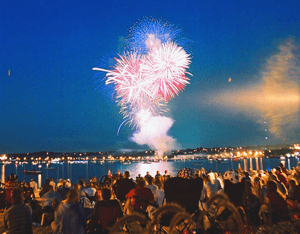
Barrie has many places for performing and fine arts. There are several live performance groups. These include Theatre by the Bay, Talk Is Free Theatre, and the Huronia Symphony. Other groups like The Strolling Youth Players and the Kempenfelt Community Players also perform in Barrie. Georgian College also hosts an annual concert series.
Performing Arts Venues
Barrie has two main places for performing arts: the Five Points Theatre and the Georgian Theatre.
- The Five Points Theatre was finished in 2011. It is in downtown Barrie. This modern building hosts many professional and amateur shows. These include film screenings, plays, concerts, and dance recitals. It is also the main home for Theatre by the Bay and Talk Is Free Theatre Companies. The theatre has a flexible stage with special lighting and sound. It can seat 120-200 people.
- The Georgian Theatre is a professional performing arts center. It is located at Georgian College in northern Barrie. This theatre has a traditional stage and seating for 427 people. It can be expanded to seat up to 690. It is used for both theatre and other events like conferences.
Art Galleries
The well-known MacLaren Art Centre is in Barrie. This art gallery inspired the "Art City" project. This project has placed many large sculptures around the city. You can find these sculptures in parks and along the waterfront.
Barrie also has many smaller, independent galleries and studios. Many of these are found in Lakeshore Mews, behind downtown's Dunlop Street. Artists from Lakeshore Mews also organize "Arts ce Soir" each year. This is an all-night art event that celebrates visual art, music, theatre, and literature.
There is also an Images Studio Tour in the Barrie/Orillia area every year. It happens on the Canadian Thanksgiving weekend. Over 25 artists take part, showing their work. This includes potters, jewellers, painters, textile artists, and fashion designers.
Festivals and Events
Barrie is home to Kempenfest. This is one of the biggest outdoor arts and crafts festivals in Ontario. It happens every year on the August long weekend. It features over 300 artists, an antique show, food, kids' activities, and live music.
Since 2021, Barrie has held Open Air Dunlop. During this event, Dunlop Street downtown is closed to cars. This helps attract more visitors to the downtown area.
Arts and Culture Groups
Some of the main arts and culture groups in Barrie include:
- Barrie Art Club
- Barrie Concert Band
- Barrie Film Festival
- Barrie Folk Society
- Campus Gallery
- Caribbean Culture Institute
- Huronia Symphony Orchestra
- Kempenfelt Community Players
- King Edward Choir
- Lyrica Chamber Choir
- Simcoe Contemporary Dancers
- Talk Is Free Theatre
- Theatre By The Bay
- Kiwanis
Attractions and Recreation
Barrie has many places for recreation and community activities:
- Allandale Recreation Centre
- Barrie Community Sports Complex
- Barrie Public Library
- Dorian Parker Centre
- East Bayfield Community Centre
- Eastview Arena
- Holly Community Centre
- Lampman Park
- Lampman Lane Community Centre
- Parkview Community Centre
- Southshore Community Centre
- Victoria Village
- YMCA of Barrie
- Shak's World Community Centre
Sports in Barrie
| Club | League | Venue | Established | Championships |
|---|---|---|---|---|
| Simcoe County Rovers | League1 Ontario | J.C. Massie Field | 2022 | 1 |
| Barrie Colts | OHL Hockey | Sadlon Arena | 1995 | 1 |
| Barrie Baycats | IBL Baseball | Vintage Throne Stadium | 2001 | 7 |
| Georgian Grizzlies | OCAA | Georgian College | 1967 | |
| Barrie Sharks | PWHL Hockey | East Bayfield Community Centre | 2011 | 0 |
| Barrie Rugby | ORU Rugby | Jim Hamilton Field | 1967 | 0 |
Barrie is also home to the Mariposa School of Skating. This school has trained many famous figure skaters. These include Brian Orser, Elvis Stojko, and Jeffrey Buttle.
Getting Around Barrie
Airports Near Barrie
Barrie does not have a major airport with regular flights. The closest big airport is Toronto Pearson International Airport in Mississauga. However, there are a few smaller airports for light aircraft:
- Lake Simcoe Regional Airport
- Barrie/Little Lake Water Aerodrome
- Springwater (Barrie Airpark) Aerodrome
Roads in Barrie
Ontario Highway 400 is the main road connecting Barrie and Toronto. It runs through the middle of Barrie from north to south. Ontario Highway 26 is another important road. It is known as Bayfield Street within the city. It leads to the Collingwood area.
Barrie was once served by other highways like 27, 90, 93, 131, and 11. But in the late 1990s, the province changed many highways. These are now called Simcoe County Road 27, Simcoe County Road 90 (Dunlop Street), and Simcoe County Road 93. The part of Highway 11 that goes through Barrie is called Yonge Street.
Major roads within Barrie include Mapleview Drive, Ferndale Drive, Big Bay Point Road, Essa Road, Huronia Road, Cundles Road, Anne Street, Dunlop Street, Livingstone Street, Duckworth Street, Wellington Street, and St. Vincent Street.
Public Transportation
Barrie Transit provides public transportation within the city. It operates many bus routes. They also offer accessible transit for those who need it. Most regular bus routes use low-floor vehicles, making them easy to use.
Barrie also has GO Transit trains and buses. These connect the city to the Greater Toronto Area.
Commuter Trains
GO Transit offers daily train service to the Greater Toronto Area. Trains run on the Barrie line from the Allandale Waterfront GO Station and the Barrie South GO Station. This service is mainly for people traveling to Toronto for work or school. There is also limited weekend service. Barrie used to be a stop for the Northlander train, but that service was rerouted.
Buses for Travel
Besides trains, GO Transit also has daily bus service to the Greater Toronto Area. Ontario Northland operates bus routes to and from Barrie from various places. All inter-city buses use the Barrie Transit Terminal at 24 Maple Street.
Barrie was once served by private bus lines like Greyhound Canada. Greyhound ended all its service in Ontario in May 2021.
Barrie is also served by Simcoe County LINX. This service connects different towns within Simcoe County, such as Orillia, Midland, and Penetanguishine.
Historical Passenger Rail
In the past, Barrie had regular passenger train service. Allandale Station was a stop for the Grand Trunk Railway, Canadian National Railway, and Via Rail. Ontario Northland's Northlander also stopped there. Regular passenger train service to the station ended in the 1980s. It has mostly been replaced by regional commuter trains.
Education in Barrie
Barrie has two main English public school boards. The Simcoe County District School Board manages public education. The Simcoe Muskoka Catholic District School Board serves Catholic students. Barrie also has two French school boards: Conseil scolaire catholique MonAvenir (Catholic) and Conseil scolaire Viamonde (secular). There are also several private schools for different age groups.
High Schools in Barrie
- Barrie North Collegiate Institute
- Bear Creek Secondary School
- Eastview Secondary School
- École secondaire catholique Nouvelle-Alliance
- Innisdale Secondary School
- Maple Ridge Secondary School
- St. Joseph's High School
- St. Joan of Arc High School
- St. Peter's Catholic Secondary School
- École secondaire Roméo-Dallaire
- Unity Christian High School
Georgian College
Georgian College's main campus is in Barrie. It has over 10,000 full-time students and about 25,000 part-time students.
Media in Barrie
Online News
Village Media runs BarrieToday.com, an online news source.
Print Newspapers
Barrie has both semi-weekly and monthly newspapers. The Barrie Advance is a free newspaper. It started in 1983 and is delivered weekly to homes in Barrie and nearby areas. It includes local news, classifieds, and ads. Barrie Business is a free monthly paper that covers local business news.
The Barrie Examiner was one of Canada's oldest daily newspapers, started in 1864. It was published five days a week. However, it closed on November 27, 2017.
Radio Stations
Local radio stations serving Barrie include:
| Frequency | Call sign | Branding | Format | Owner | Notes |
|---|---|---|---|---|---|
| FM 93.1 | CHAY | Fresh Radio | Hot adult contemporary/Top 40 | Corus Entertainment | |
| FM 95.7 | CFJB | Rock 95 | active rock | Central Ontario Broadcasting (Rock 95 Broadcasting (Barrie-Orillia) Ltd.) | |
| FM 98.5 | CKEY-FM | tourist information | Douglas George Edwards | CKEY-FM, Tourist, Barrie - Canadian Communications Foundation CKEY-FM Barrie, ON - fccdata.org | |
| FM 100.3 | CJLF | Life 100.3 | Christian radio | Trust Communications Ministries, Inc. | |
| FM 101.1 | CIQB-FM | Big FM | Classic Hits | Corus Entertainment | |
| FM 106.7 | CFRH-FM-1 | Community radio (French) | Radio-Huronie(La Clé d'la Baie en Huronie, Association Culturelle Francophone) | Rebroadcaster of CFRH-FM Penetanguishene | |
| FM 107.5 | CKMB-FM | Kool FM | Hot adult contemporary | Central Ontario Broadcasting (Rock 95 Broadcasting (Barrie-Orillia) Ltd.) |
You can also hear radio stations from other nearby cities in Barrie.
Television Stations
CKVR-DT is the only local television station in Barrie. It is part of the CTV 2 system. It produces local news every weekday and weekend.
Television stations and repeaters near Barrie include:
| OTA virtual channel (PSIP) | OTA channel | Rogers Cable | Call Sign | Network | Notes |
|---|---|---|---|---|---|
| 3.1 | UHF | 10 | CKVR-DT | CTV 2 | |
| 7.1 | 7 | 3 | CIII-DT | Global Television Network | |
| – | – | 10 | – | Rogers TV | Community channel for Rogers Cable subscribers |
Famous People from Barrie
Many notable people have connections to Barrie:
- Brent Burns (born 1985), a professional ice hockey player for the Carolina Hurricanes.
- Matthew Di Leo (born 1995), a racing driver.
- Mark Dilley (born 1969), a racing driver.
- Mitchell Hooper (born 1995), a strongman who won 2023 World's Strongest Man.
- Rebecca Hornbrook (born 1975), an atmospheric chemist.
- Michael Hutchinson (born 1990), a professional ice hockey goalie.
- Gordon Meeking (born 1890), a retired NHL player.
- Slava Pastuk (born 1990), a music journalist and author.
- Darrin Shannon (born 1969), a retired NHL player.
- Darryl Shannon (born 1968), a retired NHL player.
- Daniel Vandervoort (born 1994), a CFL wide receiver.
- Samantha Win (born 1991), an actress and martial artist.
Images for kids
See also
 In Spanish: Barrie para niños
In Spanish: Barrie para niños


